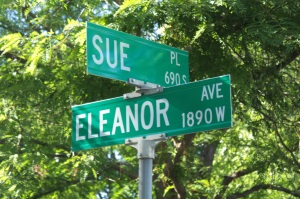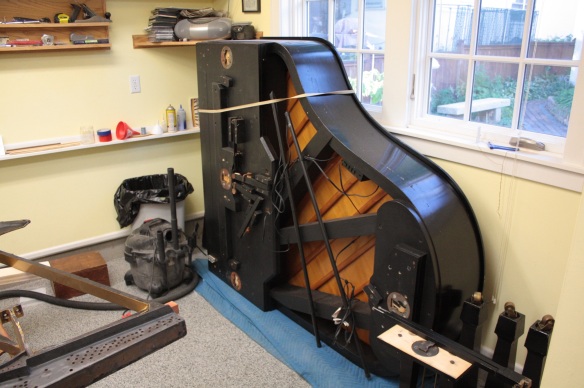This is a recap of a very short ride I took on September 22, 2013. It is one of many as I ride every block of every street in Saint Paul.
4.6 miles Highland Park
Sunday afternoons in fall I play football which really cuts my bike riding time. But with the weather in the mid-70s, I jumped on the bike after football for a short spin around some of the Highland Park streets I’d not yet ridden. I found a shrunken version of an Easter Island statue on Mount Curve Avenue.
Three neighboring streets in Highland Park between Fairview Avenue on the east and Cleveland to the west boast the women’s names Josephine, Eleanor and Sue. My go-to source on street names, Don Empson’s “The Street Where You Live”, only offers the source for Sue Place. According to the book, it was named after Sue Fry, who with her husband James, platted one of the neighborhoods nearby.
I buzzed around a couple other streets in the immediate neighborhood and rode north and west to Juno Avenue where I met up with Mark Humphrey. Mark is a piano technician who refurbishes pianos in his fully equipped, climate controlled, two level garage workshop.
This day he had three grand pianos in various stages of repair in the workshop.
The way Mark explained it, his piano fixing career is the result of a series of things he did as a boy and young man. Mark’s interest in pianos began as a boy; he loved to play but wasn’t, in his words, “ambitious enough to practice very hard.”
When he was about 10, Mark’s father taught him to use tools. “He worked with his hands and taught me how to use saws, chisels, screwdrivers and hammers and all that kind of stuff.”
His subsequent experience came several years later, “When I was about 17 I built myself a harpsichord. They used to have harpsichord kits-well they still have them-where you don’t have to make any of the action pieces or anything like that, you just make the body of the instrument and you assemble the action from a kit.”
Mark’s next major opportunity came as a counselor for a summer camp where there were four ‘low quality’ pianos. “I set out to get the piano in the main lodge (so) that every key would work, that it would be close to being in tune. And I did it! It took me the whole summer but I got it done and I just really enjoyed that.”
Then Mark went to college, got his degree and landed a job-as an economic researcher for a consulting firm. “Twenty minutes into my first morning at work I knew I hated my job.” Mark stuck it out for two months before quitting.
He enrolled in the piano tuning class at the McPhail Center in Minneapolis. Upon completion, Mark worked in the restaurant industry while he built his piano business. “The first two to three years I basically didn’t charge for anything. I called up daycare centers, I called up churches. I said, ‘You know, I’m learning this trade. If you have pianos in your basement that your regular piano tuner doesn’t want to mess around with, you know, I’m really happy to do this for free.’”
Most of those pianos were old-style uprights but the experience got him a freelance gig tuning pianos on the store floor for Schmidt Music. It took about eight years for Mark’s business to become self-supporting.
Mark landed his first big client, Augsburg College, in 1979. At the time Augsburg had three Steinway concert pianos; now they have nine that Mark keeps in pristine shape.
Other clients include the Minnesota Orchestra (it’s been more than a year since he’s worked there because of the lockout of the musicians), the Ordway, Prairie Home Companion, Carleton College and many private home customers.
“I love my private home customers. They almost become friends to me after all these years.”
Mark’s 35 year career has involved some memorable pianos and experiences. The most expensive instrument he’s repaired is a $150,000 Steingraeber piano, with an all black exterior. Inside it is decorated with a Birdseye maple veneer and the underside of the lid is quartered mahogany burl veneer splashing out in four directions.
Still, Steinway concert pianos remain his favorite. “They’re the work of absolute engineering genius. They’re a truly amazing piano. There is no other piano in the world that provides the combination of power, beauty and color that a Steinway piano does.”
One notable experience involved rehabbing a piano inside a home that suffered a freak lightning strike that blew the soundboard to smithereens.
Another began with an 11 p.m. phone call from the Ordway. During a performance the pianist dropped his cufflink into the piano and insisted it be retrieved right away. So Mark drove to the Ordway and met the unnamed pianist . ” And he says, ‘I have to get my cufflink.’ So I take the piano apart and find the cufflink and it had a diamond that big around. No wonder he wanted his cufflink back right away.”
Mark gave me some history on the most complete piano, a Steinway, in his workshop. “This piano was built before the first World War. Kaiser Wilhelm, Nicholas the Second, Czar of Russia, Abdul Hamid, the Sultan of Turkey. About 1915 they no longer put these on their pianos.”

The names and coats of arms of some of the world’s leaders who owned Steinway and Sons pianos around 1912.
Surprisingly, pianos are not collectible as antiques. “There is absolutely zero antique value in pianos because there are 500,000 of these, almost 600,000. They are not rare at all. The value that they have is because of their value as musical instruments.”

These planks of five ply hard rock maple are used to make new pin blocks. Today one of these five foot boards costs about $800, compared to about $100 25 years ago.
Restoring a concert-quality piano is an expensive proposition-$30,000 or more. Over the past 25 years the cost of materials have soared, according to Mark. “They were probably about 15% of the cost of a restoration, now they’re over 50% of the cost. Labor costs have not gone up that much but materials are just outrageous.”
Technology has little to no effect upon the piano manufacturing industry. However, the business has shrunk by 90% so it’s much harder to get quality materials. Steinway makes only 1,500 pianos a year.
Mark disclosed several other interesting facts:
- A good piano renovation should last about 100 years
- He spends about 130 hours on an average refurbishing a piano.
- Mark estimates he’s restored at least 150 Steinways and tuned roughly 30,000 pianos.
- Mark still feels his business is fun but has cut back to about half-time.
This ride was a departure from my others, mainly because of the short distance I covered. And like nearly every other ride, I learned from and was entertained by someone I met on my trek.
All the details of the huge 4.6 mile ride can be found here: http://www.mapmyride.com/routes/view/347494789









